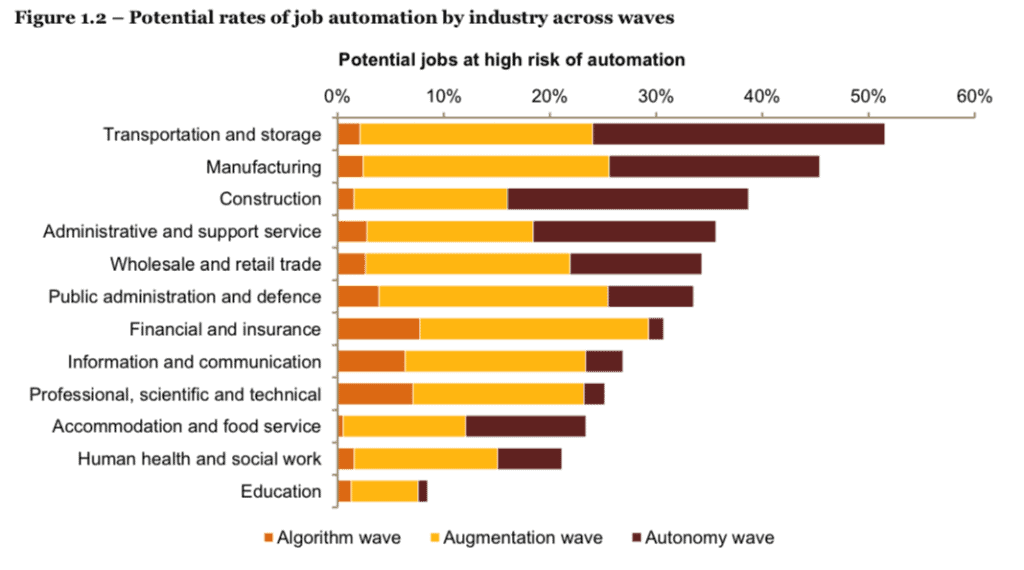The robots are coming – and with them, a change in how work is conducted, organized and divided between humans and machines. But what will the impact of automation on employment really be?
Table of Contents
ToggleMost analysts agree that many jobs will be lost to automation – while many more will also be created. However, as the MIT Technology Review discovered last year when it analyzed several reports published by a wide range of companies, think tanks and research institutions, little consistency exists between experts as to how deeply the impact of automation on employment will be felt over the next few years.

(Source: MIT Technology Review)
“As you can see, no one agrees,” writes Erin Winick, former Space Reporter for the MIT Technology Review. “Predictions range from optimistic to devastating, differing by tens of millions of jobs even when comparing similar time frames. In short, although these predictions are made by dozens of global experts in economics and technology, no one seems to be on the same page. There is really only one meaningful conclusion: we have no idea how many jobs will actually be lost to the march of technological progress.”
Actually, there is another meaningful conclusion that can be drawn. Change is coming – all papers and experts agree on this front. It’s only timeframes and the scale of the impact of automation on employment that’s up for debate.
So, let’s take a closer look at some of the findings from these reports – and others that have been published since – to see if we can draw our own conclusions.
The 3 Waves of Automation
As Winick points out, the most commonly cited numbers by commentators come from three places: a McKinsey report that estimates 400 to 800 million jobs worldwide could be automated by 2030; an OECD study that suggests that 9% of jobs are automatable; and a 2013 Oxford study (removed from the table at the authors’ request because it doesn’t give a specific job loss figure or timescale) that said 47% of US jobs are at high risk of automation in the next few decades.
These are indeed wildly differing figures – so why is it that there is no clear consensus on the impact of automation on employment? As KPMG stated in its report Rise of the Humans 3, “In any sector you care to name, predictable planning horizons are collapsing with alarming speed and as they do, even the experts cannot agree on AI’s ultimate workforce impact. Some predict jobs will multiply following a disruptive transition period. Others foresee a net loss of jobs to the economy and warn of the need to explore policy solutions such as a universal basic income or a reduced working week.”
Much of the trouble seems to come from predicting the rate of change. PwC, in its Will Robots Really Steal Our Jobs? paper, predicts three separate waves of automation that will progressively come sweeping in between now and the mid-2030s.

(Source: PwC)
The first is the Algorithm Wave. Already well underway, it involves automating structured data analysis and simple digital tasks – such as credit scoring in the financial services sector, for instance. PwC predicts this wave could reach maturity by the early 2020s.
Next will come the Augmentation Wave – also underway, though not likely to reach maturity until the late 2020s. The Augmentation Wave is focused on the automation of repeatable tasks (see Everything You Need to Know About Robotic Process Automation) and exchanging information, as well as further developments in manufacturing and warehouse robots, aerial drones, and semi-autonomous vehicles.
Finally, the third Autonomy Wave could come to maturity by the mid-2030s, when AI will likely be able to analyze data from multiple sources, make decisions and take real – including physical – actions in real-time with little or no human input. For example, fully-autonomous driverless vehicles could roll out at scale across the economy in this phase, impacting driving employment in a big, big way.

(Source: PwC)
Who Will Feel the Impact of Automation on Employment First and Most?
As each wave comes rolling in, which sectors are likely to feel the impact of automation on employment first, and are there any demographics that are particularly vulnerable?
These are the question that McKinsey Global Institute (MGI) set out to answer in its 2019 paper The Future of Work in America: People and Places, Today and Tomorrow. Like PwC, MGI believes that the impact of automation on employment will not be felt evenly across industries and timeframes. For example, beneath the Algorithm Wave, financial services jobs are relatively susceptible to automation in the shorter term, while driving and transportation jobs are more vulnerable in the longer term when the Autonomy Wave finally takes hold.
Looking at 16 occupational categories by share of US employment and displacement rate through 2030, MGI finds that the coming waves of automation (Algorithm and Augmentation, in PwC’s terms) will affect some of the largest occupational categories in the US economy, including office support, food service, production work, customer service, and retail sales. In fact, nearly 40% of current US jobs are in occupational categories that could shrink between now and 2030, MGI says. The common thread among these shrinking roles? They involve many routine and/or physical tasks that are ripe for automation.

(Source: McKinsey.com)
As such, less-educated workers are most likely to be displaced, MGI says, while automation will pose particular challenges for the youngest and oldest workers.
Individuals with high school degrees or less are four times more likely to be in a highly automatable role than individuals with a bachelor’s degree or higher – and as much as 14 times more vulnerable than someone with a graduate degree. This has a particular impact on certain demographic groups that have lower educational attainment. MGI finds, for instance, that Hispanic workers are overrepresented in foodservice roles and have the highest rate of potential displacement among all minority groups – 25.5 %, or 7.4 million individuals. The potential displacement rate for African Americans is 23.1 % (4.6 million people). For white workers, the rate is 22.4%, while Asian-American workers have the lowest rate at 21.7%.
Young people, meanwhile, will likely need to build new career paths and find new ways to gain a foothold in the working world. While previous generations often found their first jobs in retail or food service – roles that gave them their first taste of work and embedded valuable soft skills and experience that would stay with them forever – these are the very roles that automation could soon phase out. In all, roughly 14.7 million workers under the age of 34 could soon be displaced by automation.
For those over 50, the impact of automation on employment is to the tune of 11.5 million US workers. Though some are of course already close to retirement, others have many years ahead of them yet. Will they be willing or able to make a drastic change – to reskill themselves after spending much of their career doing one thing – to train for different lines of work?
And what about the gender divide? A UK study by the Office for National Statistics (ONS) found that 70.2% of the roles at high risk of automation in the short term are currently held by women. However, MGI takes a longer view and concludes that women may be better positioned for future job growth. Many specific jobs skew towards one gender or the other – women, for example, make up the majority of bookkeepers and administrative assistants, while drivers and assembly line workers are predominately male. Overall, MGI’s midpoint automation scenario suggests that women currently represent 47% of workers that will be displaced by automation, while men represent 53%. Based on the current gender share of occupations, MGI predicts that women could capture 58% of net job growth through 2030.
MGI’s research only considers jobs that exist today. The fact is, however, that technology is likely to create new jobs we cannot even imagine at present. In fact, MGI’s research suggests that about 8% to 9% of jobs in 2030 will be ones that do not yet exist. However, currently, men are more heavily represented in “frontier” jobs that involve cutting-edge technologies – and this may put them in a better position for the jobs that have yet to emerge. As ever, the need to improve the representation of women in the tech sector remains a priority.
Final Thoughts
As experts and analysts around the world peer into their crystal balls, though they can’t seem to agree upon the precise extent of the impact of automation on employment, what is certain is that there will be an impact – across every sector, every role and every demographic. It seems that in the long run, less well-educated workers are particularly exposed to automation, as they tend to be employed in roles that have the greatest potential to be automated. And this emphasizes the importance of increased personal and company investment in lifelong learning and retraining. While some roles are more vulnerable to automation in the shorter term than others, all workers – as well as young people still in education – need to start planning and preparing for the future. We leave you with this parting piece of advice from the MGI report.

Impact of Automation on Employment
Automation will bring change, but what will the true impact of automation on employment really be? Most analysts agree that many jobs will be lost to automation – while many more will also be created. However, as the MIT Technology Review discovered last year when it analyzed several reports published by a wide range of companies, think tanks and research institutions, little consistency exists between experts as to how deeply the impact of automation on employment will be felt over the next few years. Change is coming – all papers and experts agree on this front. It’s only timeframes and the scale of the impact of automation on employment that’s up for debate.





